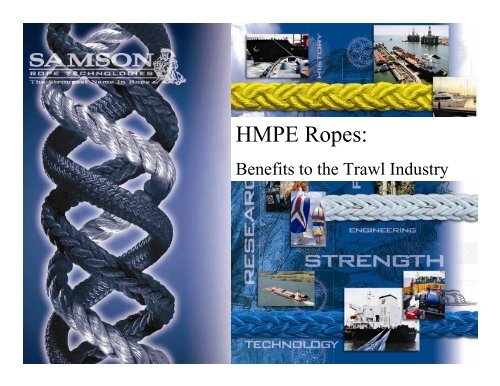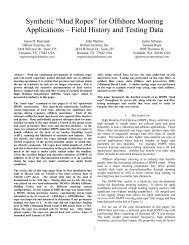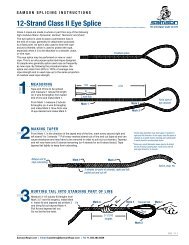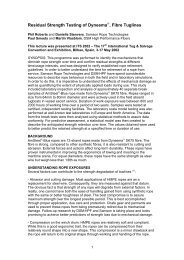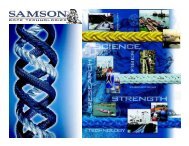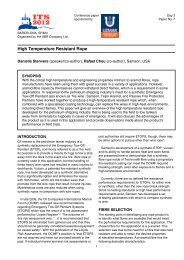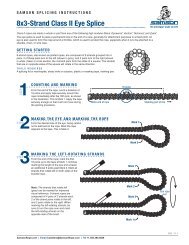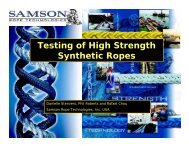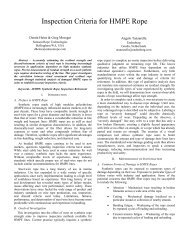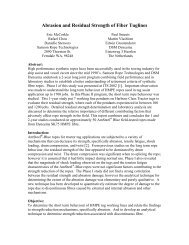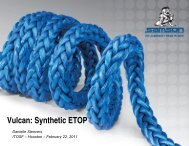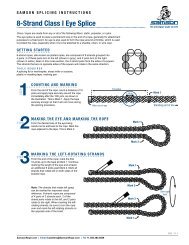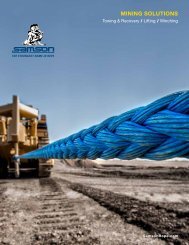HMPE Ropes: - Samson Rope
HMPE Ropes: - Samson Rope
HMPE Ropes: - Samson Rope
- No tags were found...
Create successful ePaper yourself
Turn your PDF publications into a flip-book with our unique Google optimized e-Paper software.
<strong>HMPE</strong> <strong><strong>Rope</strong>s</strong>:Benefits to the Trawl Industry
<strong>HMPE</strong>-Synthetic Wire <strong>Rope</strong> <strong>HMPE</strong> fiber rope has been effectivelyused as wire rope replacement forapplications that require manualhandling or reduced weight. Today’s Trawl Applications• Gilson Lines• Trawl Net Bridles• Framing <strong><strong>Rope</strong>s</strong>• Cod End Rib Lines• Lifting Straps
Presentation OverviewCurrent uses in Trawl industry• <strong>HMPE</strong> wire rope replacement• Economic Value• Benefits over Tradition fiber ropes<strong>HMPE</strong> Fiber Properties<strong>Rope</strong> PropertiesRetirement
Major Uses of <strong>HMPE</strong> ropes Wire <strong>Rope</strong>Replacement• Gilson Lines• Trawl Net Bridles Chain replacement• Cod End Rib Lines TraditionalSynthetic <strong>Rope</strong>Replacement• Framing ropes
Wire Replacement: Key benefitEconomic ValueHandlingRigging Hardware costsLongevityMiscellaneous
Economic Value: Handling.Size-for-Size
Economic Value: Handling.Weight 1” 12 Strand <strong>HMPE</strong><strong>Rope</strong>• 21.8 lbs for 100feet 1” IWRC Wire<strong>Rope</strong>• 185 lbs for 100 feet
Economic Value: Rigging CostsHardware Reduction ofcomponents:• Flatlinks• G-Hooks• Hammerlocks Elimination ofcomponents• SwivelRollerbearing Lifetime costreduction
Economic Value: Longevity.TCLL Test MethodTCLL – Level of load that fatigues rope to breakat the 1000th cycle- fatigue resistance test1. 50% of rope’s breaking strength – 1000 cycles2. 60% of rope’s breaking strength – 1000 cycles3. 70% of rope’s breaking strength – 1000 cycles.4. …..continue the procedure at 10% incremental ofbreaking strength till rope breaks. The results are then used to calculate a TCLLvalue which theoretically represents the load(expressed as a % of the breaking strength) atwhich the rope would fail at exactly 1000 cycles.
Economic Value: Longevity.TCLL Test Results
Economic Value: Longevity.
Economic Value: Longevity.Bending Fatigue (D/d = 25)
Economic Value: MiscellaneousLubricating wireDamage to the vessel
Wire <strong>Rope</strong> ReplacementEconomic Value:Reduced InjuriesReduced crew fatigueReduced Seasonal Hardware costsIncreased lifetimeLess Maintenance
Traditional <strong>Rope</strong> Replacement.Key BenefitsIncreased LifetimeWeightBetter Abrasion resistance
Abrasion Resistance
<strong>HMPE</strong> fibersHigh Modulus Polyethylene Fiber• Dyneema-DSM High PerformanceFibers, The Netherlands• Spectra-Honeywell, USADyneema• SK-60• SK-75Spectra• Spectra-900• Spectra-1000
<strong>HMPE</strong> fiber propertiesSpectraDyneemaSpectraDyneema900SK-601000SK-75Modulus720102011501280g/denierStrength27323540g/denierWeight1600160013001600denierDensity0.970.970.970.97g/ccElongation4.43.63.43.6%Cross-section
<strong>HMPE</strong> fiber ropesImportant <strong>Rope</strong> Properties• Strength• Initial Strength• Strength after usage• Weight• Abrasion resistance
Measurements of Properties<strong>Rope</strong> properties are a function ofthe test method used to measurethem.Weight• Relaxed weight• Reference load weightInitial <strong>Rope</strong> Strength• ISO Standard-measures un-terminatedrope strength• CI Standard-measures spliced ropestrength
Measurements of Properties<strong>Rope</strong> strength after usage• All material generally get weaker withuse.Abrasion Testing• Not directly comparable to real worldenvironments.• Used to qualitatively compare materials
<strong>HMPE</strong> Fiber <strong><strong>Rope</strong>s</strong> Properties:Initial Strength<strong>Rope</strong> Design• <strong>Rope</strong> Construction• Twist Levels• Pick Angle• CoatingOptimize Construction forApplication
<strong>HMPE</strong> Fiber <strong><strong>Rope</strong>s</strong> Properties:Initial StrengthPost-Processing• Heat• TensionIncrease strength up to 25% andreduce diameter by 20%
Post Processing Effects:Initial strength vs Longevity
Post Processing Effects:Initial strength vs Longevity
<strong>Rope</strong> Performance:Mechanisms influencing LongevityNew <strong>Rope</strong>:• Construction• ProcessingUsed <strong>Rope</strong>• Abrasion• Impact/Shock Loading• Drum compression• Cyclic fatigue• Induced Twist
Effects of Abrasion
At t = 0Reference 31.500 kg 100 %At t = 4190 cycles @ 60% Reference1. Drum layer 1 24.860 kg 79 %2. Drum layer 2 24.260 77 %3. Drum layer 3 26.610 84 %4. Buried rope 26.750 85 %5. Horizontal part 31.920 101 %6. Bending point 30.550 97 %Horizontal part = Tensile Fatiguenot an issue
Effects of Tensile Fatigue
Develop Retirement Criteria
RetirementCurrent Retirement:• Gilson lines- 1-2 seasons• Bridles- 4 seasons• Framing <strong><strong>Rope</strong>s</strong> –Not defined (3+seasons)Retirement based onusage/residual strength
Conclusions<strong>HMPE</strong> ropes provide soundeconomic value over wire rope.• Reduced Injuries• Reduced crew fatigue• Reduced Seasonal Hardware costs• Increased lifetime• Less MaintenanceNot all <strong>HMPE</strong> fibers are the sameNot all <strong>HMPE</strong> ropes are createdequalRetirement Guidelines based onusage


